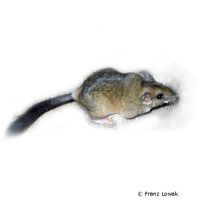Bushy-Tailed Jird (Sekeetamys calurus)
| Bushy-Tailed Jird Sekeetamys calurus | |
|---|---|
| Name | Bushy-Tailed Jird |
| Name Lat. | Sekeetamys calurus |
| Family | Murids |
| Family lat. | Muridae |
| Order | Rodents |
| Order lat. | Rodentia |
| Origin | Near East |
| Climate | Subtropical |
| Habitat | Semi-desert |
| Diet | Seeds, green fodder, insects |
| Behavior | Nocturnal |
| Keeping | Pair, group |
| Care Level | Easy |
| Life Span | 4-5 years |
| Protection | No |
| Metric Units | |
| Size | 10-12 cm |
| Temperature | Room temperature |
| Housing | A: 0.5 m² / H: 50-60 cm |
| US Units | |
| Size | 3.9"-4.7" |
| Temperature | Room temperature |
| Housing | 5 ft² / 20" hight |
Distribution and habitat
The range of the crepuscular and nocturnal bush-tailed gerbils extends from eastern Egypt across the Sinai Peninsula and Israel to Jordan and Saudi Arabia. There they live in the dry, rocky semi-deserts and mostly stay in self-dug burrows during the day.
Maintenance
Minimum dimensions for the enclosure:
| 1-2 animals | area: 0,5 m² | height: 50-60 cm |
| Each additional animal | Area: + 20 |
A terrarium placed in a bright (no direct sunlight), draught-free and quiet place is recommended, with ventilation openings on the sides, and it must not be tightly closed at the top
The enclosure should be diversely structured with stones, roots and branches, and provide hiding and shelter opportunities (rodent houses, tubes, clay caves, etc.). They need food and drinking containers (drinking bottles), a sand bath (chinchilla sand) for grooming, nesting material (hay, straw, etc.) and a substrate for digging. Commercially available small animal litter or a sand-peat mixture covered with some bark mulch, dry leaves, hay and straw is suitable as a substrate. The bedding depth should be at least 10 cm, better 20 cm. Nail material, such as untreated twigs and branches of fruit trees, as well as a rodent stone, must always be available to wear down their teeth. They should be kept at room temperature and their natural day-night rhythm should be respected.
Diet
Their diet is mainly vegetarian, but they also need animal protein. The diet consists of a low-fat grain mixture, available in specialized shops as "gerbil food", supplemented with forage hay, cob millet, some green food (root vegetables, wild herbs, zucchini, etc.) and a mineral stone. In addition, they need animal protein, such as live insects (crickets, house crickets, mealybug larvae), cottage cheese, a hard-boiled hen's egg or insect food for hedgehogs. Fruit must be offered infrequently and in very small quantities. Drinking water must always be available in hanging bottles or in stable, open containers and, like food, must be offered fresh daily
A varied diet promotes health and prevents deficiency symptoms.
Behaviour and compatibility
In nature they live in loose family groups. They are social and peaceful animals that should be kept in pairs or better in a group. Even in larger groups, aggression rarely occurs, and if there is sufficient room for retreat, even socialization of groups is successful. At the first signs of incompatibility, the animals should be separated immediately.
Reproduction and breeding
Testes can be clearly seen in sexually mature males, and the distance between the anus and the urethral opening is greater in juvenile males than in females.
The gestation period is about 3 weeks. The average of 4-6 young are born naked, blind and deaf, are independent after 4-6 weeks and should remain with the mother for a few days afterwards. After about 3 months they are sexually mature. The life expectancy is 4-5 years.
Important
They are very agile, run quadrupedally and flee in danger kangaroo-like hopping on their hind legs. They should not be fed too much, because they easily become fat. They are extremely curious and can become very trusting, but this does not mean they are petting animals.
It has been proven to cover part of the enclosure with bedding and the other part with a sand and peat mixture. Running wheels must be injury-proof, have a closed running surface and back wall, with a diameter that the animals can run without bending their backs. As escape animals, they need sufficient retreat and hiding places, so the enclosure should also be somewhat elevated and not placed on the floor
They should not be grabbed or pulled by the tail, as the skin can easily crack and detach. The animals should only be grasped by hand from below and lifted up. Particular attention should be paid to thorough hygiene and contamination should be removed regularly.
Further literature can be found in your pet store.
References
Text: petdata; Image: Franz Lowak
Source: W. PUSCHMANN, D. ZSCHEILE, K. ZSCHEILE (2009): Zootierhaltung - Tiere in menschlicher Obhut: Säugetiere, Harri Deutsch Verlag; EHRLICH (2006): Kleinsäuger im Terrarium, Natur und Tierverlag; BMEL (2014): Gutachten über Mindestanforderungen an die Haltung von Säugetieren
- Gemäß § 21 Abs. 5 Tierschutzgesetz idgF
